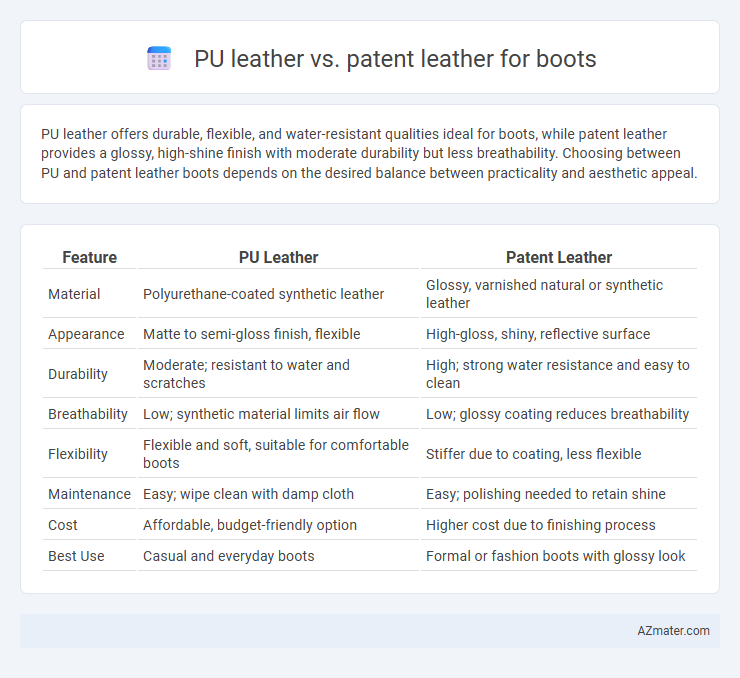PU leather offers durable, flexible, and water-resistant qualities ideal for boots, while patent leather provides a glossy, high-shine finish with moderate durability but less breathability. Choosing between PU and patent leather boots depends on the desired balance between practicality and aesthetic appeal.
Table of Comparison
| Feature | PU Leather | Patent Leather |
|---|---|---|
| Material | Polyurethane-coated synthetic leather | Glossy, varnished natural or synthetic leather |
| Appearance | Matte to semi-gloss finish, flexible | High-gloss, shiny, reflective surface |
| Durability | Moderate; resistant to water and scratches | High; strong water resistance and easy to clean |
| Breathability | Low; synthetic material limits air flow | Low; glossy coating reduces breathability |
| Flexibility | Flexible and soft, suitable for comfortable boots | Stiffer due to coating, less flexible |
| Maintenance | Easy; wipe clean with damp cloth | Easy; polishing needed to retain shine |
| Cost | Affordable, budget-friendly option | Higher cost due to finishing process |
| Best Use | Casual and everyday boots | Formal or fashion boots with glossy look |
Introduction to PU Leather and Patent Leather
PU leather, a synthetic material made from polyurethane, offers cruelty-free durability and water resistance, making it an economical alternative to genuine leather for boots. Patent leather is a coated leather with a high-gloss finish created by applying a lacquer or varnish, prized for its shiny, formal appearance and smooth texture. Both materials provide distinct aesthetic and functional qualities for boots, with PU leather emphasizing flexibility and cost-effectiveness, while patent leather highlights a polished, luxurious look.
Key Differences Between PU Leather and Patent Leather
PU leather, a synthetic material made from polyurethane, offers flexibility and water resistance, making it suitable for budget-friendly and durable boots. Patent leather features a high-gloss finish achieved through a lacquer coating on genuine leather, providing a sleek, shiny appearance preferred for formal footwear. Key differences include PU leather's matte or semi-gloss textures versus patent leather's mirror-like shine, as well as PU's greater breathability compared to patent leather's rigid and less breathable surface.
Material Composition and Manufacturing Process
PU leather boots consist of a fabric base coated with polyurethane, offering a flexible and affordable alternative to genuine leather. Patent leather boots feature a natural leather base coated with multiple layers of lacquer or polymer, creating a high-gloss, durable finish. The manufacturing process for PU leather involves synthetic material application and curing, while patent leather production requires extensive polishing and finishing to achieve its characteristic shine.
Durability and Longevity Comparison
PU leather boots offer moderate durability with resistance to scratches and water, making them suitable for daily wear but prone to cracking over time due to synthetic material limitations. Patent leather boots feature a high-gloss finish created by a polyurethane coating, which enhances water resistance and maintains structural integrity longer under normal use but can be susceptible to scuff marks. When comparing longevity, patent leather generally outperforms PU leather by retaining its appearance and durability with proper care, making it a better investment for long-lasting boots.
Appearance and Finish: Gloss, Texture, and Color
PU leather boots exhibit a matte to semi-gloss finish with a smooth, consistent texture that mimics natural leather, offering diverse color options enhanced by uniform dye absorption. Patent leather boots shine with a high-gloss, mirror-like surface achieved through a lacquered finish, presenting a sleek and polished appearance with a rigid texture. Color vibrancy in patent leather tends to be more intense and reflective, while PU leather allows for a wider range of subdued tones with subtle variations in shading.
Comfort and Breathability for Boots
PU leather offers enhanced breathability and flexibility, making it a more comfortable option for boots during extended wear. Patent leather, characterized by its glossy, sealed surface, tends to be less breathable and can cause feet to feel hotter and sweatier over time. Choosing PU leather boots ensures better moisture management and comfort, especially in warmer conditions or long-duration use.
Maintenance and Care Requirements
PU leather boots require regular cleaning with a damp cloth and conditioning with a PU-specific conditioner to prevent cracking and maintain flexibility. Patent leather boots demand gentle wiping with a soft, damp cloth and occasional polishing with patent leather cleaner to preserve their glossy finish and prevent scuffs. Both materials benefit from storage in a cool, dry place away from direct sunlight to avoid fading and damage.
Eco-Friendliness and Ethical Considerations
PU leather for boots offers a more eco-friendly alternative compared to traditional patent leather, as it requires less animal resource exploitation and generally utilizes synthetic materials that can be produced with lower carbon emissions. However, PU leather's environmental impact depends on the production process and end-of-life biodegradability, with some types contributing to microplastic pollution. Patent leather, derived from animal hides and coated with glossy finishes, raises ethical concerns regarding animal welfare and often involves chemical treatments that generate hazardous waste, making it less sustainable overall.
Price and Value for Money
PU leather boots offer an affordable alternative to patent leather, making them ideal for budget-conscious buyers without sacrificing style. Patent leather boots typically command higher prices due to their glossy finish and durability, providing better long-term value despite the initial cost. Choosing between PU and patent leather depends on balancing immediate price sensitivity against the potential for lasting wear and aesthetic appeal.
Choosing the Right Leather Type for Your Boots
PU leather offers a durable, water-resistant alternative ideal for budget-conscious consumers seeking a vegan option with ease of maintenance. Patent leather boasts a high-gloss finish that delivers a sleek, polished appearance while requiring more careful upkeep to prevent scratches and maintain shine. Choosing between PU and patent leather depends on balancing cost, desired aesthetic, and care preferences for your boots.

Infographic: PU leather vs Patent leather for Boot
 azmater.com
azmater.com